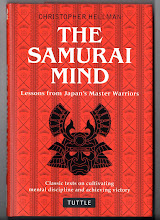 |
| Kyoto, November 2014 |
Autumn in Japan is characterised by its
mild temperature and the brilliant colours of the foliage that tinges the hills
with russets and brilliant reds, and the occasional burst or brilliance dotted
throughout the cities. However, in literature and art, the season has strong links with feelings of desolation, loss and longing, which in western
literature are more often associated with winter. Indeed, the ‘withering wind’
(kogarashi) is so intimately associated with autumn, that its mention alone is
sufficient to conjure up the season.
Such phrases used in poetry are known as kigo, and among the educated, they had
strong associations. Indeed, it with such a phrase that Yagyu Sekishusai began his
collection of 100 verses:
One autumn
evening, to while away the hours, I went to visit old friends in Yamato, but
found some of those old men had already passed away, while others had gone, I
know not where.
In fact, the term yugure
(evening) which he uses doesn’t strictly refer to autumn, but since the late
Heian period it has had particularly strong associations with the season, being
mentioned by Sei Shonagon in her Pillow Book as being the exemplary time of day
for that season. Given the generally sparse tone he takes, it would not seem
out of place to translate it as autumn evening, rather than simply evening.
Other common symbols of autumn include
deer, the full moon, flying geese, the seven grasses of autumn (nanagusa) and,
of course, momiji or scarlet maple leaves.
Despite the strong seasonal associations,
there is less specific mention of such symbolism in traditional martial arts
than might be imagined. This may partly be owing to the strength of these
cultural associations – loneliness and loss, though all fine and good in
everyday life, are quite far from the kind of feelings that are normally
encouraged in the training and practice of bugei.
There are some connections, however. I have
discussed Musashi’s use of the autumn monkey (also here)(stretching for the reflection of
the full moon) before; likewise his momiji uchi (falling leaves strike) which
cuts downwards, knocking an opponent’s sword away.
 |
| Hiza-guruma - a technique of the Kito-ryu |
Occasional references also occur in other
ryu-ha – both the Mujuushin Kenpo of Harigaya Sekiun and the Kito Ryu school of
jujutsu contain what is substantially the same verse extolling the virtues of flexibility:
Autumn wind, deep in the mountains, fiercely sways and shakes
the leaves of the oak, while barely moving the pampas grasses
Rarer is the example provided by the
Jikishinkage ryu, which includes a foundation kata named Hōjō no kata, based on the
energies ascribed to the four seasons in the Chinese theory of the five
elements. Autumn, in this case, emphasizes varied tempo and cutting to left and right,
illustrating change. This specific linkage to
elements seems unusual in Japanese bujutsu - although the basic principles illustrated by the Hōjō no kata are said to have been transmitted by Matsumoto Bizen no Kami, the school's founder, it is possible that they were later reorganized and matched to the four seasons.
Still on the subject of the five elements, there is another set of verses which is worth mentioning, although this is from the Chinese art of Xinyi, and is attributed to the founder Dai Fengzhong:
Red Maples have forgotten the six alignmentsTranquility will reveal the Five ElementsThe first verse points to the naturalness and spontaneous nature of advanced technique, while alsosuggesting (at least to me) the spirit of forging oneself – the bright leaves can certainly look like hotcoals or heated metal, and I feel the specific choice of maple leaves must be saying something about the redness.
 |
| Kyoto, November 2014 |
This particular aspect was also used by Hikita Bungoro in momiji no metsuke (gaze of red leaves) in his Hikita Kage Ryu. Yagyu Jubei mentions this in his Tsuki no Sho, describing it as an important concept of the school, a technique of the mind to effect the opponent’s mind and movements from a distance, as if ‘viewing red leaves on yonder mountain.’ Jubei, on describing the technique in his own school describes it as ‘dying the opponent’s movements with the blood red intentions of your own mind.’
This symbolism might also be read into Hojo Ujimasa"s death poem:
The blossoms of spring do not resent the spring wind
For the red leaves of autumn are still to come
In this case, the blossoms would be the Hojo family, defeated by Toyotomi Hideyoshi's spring wind, while the red leaves would, perhaps, be future generations of the Hojo.
 |
| Uesugi Kenshin, by Utagawa Yoshitoshi |
Although autumn symbolism may not have featured strongly in the bugei as a whole, bushi seemed to use it often enough when they turned their hands to artistic pursuits. One example of this
is a poem by Uesugi Kenshin:
Frost
Fills the Camp and the Autumn Air is Still
Lines of
Returning Geese Cross the Moon of the Third Hour
The warrior makes
Of his armor a pillow
For his head alone
…which returns us to the theme of loneliness.
Personally, however, my own feelings are closer to Keats and his
Season of mists and mellow fruitfulness










